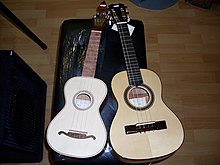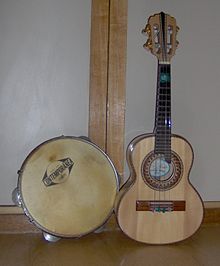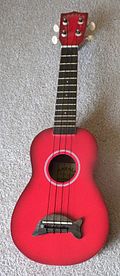Cavaquinho
 Portuguese cavaquinhos | |
| String instrument | |
|---|---|
| Other names | Machete,braguinha, manchete, cavaco |
| Classification | String instrument |
| Hornbostel–Sachs classification | (Compositechordophone) |
| Developed | Portugal |
| Related instruments | |
| Ukulele,Viola braguesa,Cuatro | |
Thecavaquinho(pronounced[kɐvɐˈkiɲu]inPortuguese) is a smallPortuguesestring instrument in the Europeanguitarfamily, with four wires or gut strings.
A cavaquinho player is called acavaquista.
Tuning[edit]
A commontuninginPortugalisC G A D(reentrant with C being the lowest pitch,[1]or from lower to higher pitches[2]).
The standard tuning inBrazilisD G B D.[3]
Other tunings include:
- D A B E–Portuguese ancienttuning, made popular by Júlio Pereira, reentrant with A being the lowest pitch[4]
- G G B D[5]
- A A C♯E
- D G B E– used for solo parts inBrazil
- G D A E–mandolintuning
- G C E A– ‘cavacolele’ tuning, the same as the soprano/tenorukulele[6]
- D G B E– the same as the highest four strings in standardguitar tuning,often used by guitarists, and the same tuning used for thebaritone ukulele[7]
Forms[edit]
There are several forms of cavaquinho used in different regions and for different styles of music. Separate varieties are named forPortugal,Braga(braguinha),Minho(minhoto),Lisbon,Madeira,Brazil,andCape Verde;other forms are thebraguinha,‘cavacolele’, cavaco,machete,andukulele.
Machete and braguinha[edit]
Themacheteis a variety of the cavaquinho fromMadeira.It is a predecessor of the modernukulele.TheMachete de Braga( “Braga-stylemachete”) is called abraguinha.
Minhoto[edit]
Theminhotocavaquinho, associated with theMinhoregion inPortugalis similar to theviola braguesa.Itsneckis on the same level as thebody.Like thebraguesa,the minhoto'ssound holewas traditionally shaped like a stylizedray (fish);the shape is called “raia”inPortuguese.
International use[edit]
Different forms of cavaquinho have been adapted in different regions. Varieties used outside ofIberiaare found inBrazil,Cape-Verde,andMadeira.The locally iconicCaribbean regioncuatro familyand theHawaiianukuleleswere both adapted from the cavaquinho.
Brazil[edit]

TheBraziliancavaquinho is slightly larger than the Portuguese cavaquinho, resembling a smallclassical guitar.Its neck is raised above the level of thesound box,and the sound hole is usually round, like cavaquinhos fromLisbonandMadeira.

The cavaquinho is a very important instrument inBraziliansambaandchoromusic. It is played with a pick, with sophisticated percussive strumming beats that connect the rhythm and harmony by playing the rhythm “comping”. Some of the most important players and composers of the Brazilian instrument areWaldir Azevedo,Paulinho da Viola,andMauro Diniz.
Cape Verde[edit]

InCape Verdethe cavaquinho was introduced in the 1930s from Brazil. The present-day Cape-Verdean cavaquinho is very similar to the Brazilian one in dimensions and tuning. It is generally used as a rhythmic instrument in Cape-Verdean music genres (such asmorna,coladeira,mazurka) but it is occasionally used as a melodic instrument.
Hawaii[edit]

TheHawaiianukulelealso has four strings and a shape similar to the cavaquinho,[8]althoughtuneddifferently – usuallyG C E A.
Theukuleleis an iconic element ofHawaiianpopular music, which spread to the continental United States in the early 20th century.[9]It was developed from the braguinha and rajão, brought toHawaiiin the late 19th century by Portuguese immigrants fromMadeira Island.[10]
Themachetewas introduced into Hawaii by Augusto Dias, Manuel Nunes, and João Fernandes in 1879, which further influenced the development of the ukulele.[11]
Northern Latin America and the Caribbean[edit]

Thecuatrois a family of larger 4-stringed instruments derived from the cavaquinho that are popular in Latin-American countries in and around theCaribbean.Versions of the iconicVenezuelan cuatroare very similar to the Brazilian cavaquinho, with a neck laid level with thesound box,like a Portuguese cavaquinho.
Origins[edit]
This articlerelies largely or entirely on asingle source.(March 2018) |
The origins of thisPortugueseinstrument are elusive. Author Gonçalo Sampaio holds that the cavaquinho and theguitarmay have been brought toBragaby theBiscayans.[citation needed]
Sampaio explainsMinho region’s archaic andHellenisticmodesby possible survival of Greek influences on the ancientGallaeciof the region, and stresses the link between this instrument and historical Hellenistictetrachords.[citation needed]
See also[edit]
Further reading[edit]
- Richards, Tobe A. (2008).The Cavaquinho Chord Bible: DGBD Standard Tuning 1,728 Chords.United Kingdom: Cabot Books.ISBN978-1-906207-09-0.– A comprehensive chord dictionary instructional guide for the Brazilian and Portuguese cavaquinho.
References[edit]
- ^"Curso de Cavaquinho - Lição nº2 - Tessitura, Escala e 4 Afinações".Retrieved16 December2023.
- ^"How to Tune a Cavaquinho".Retrieved9 June2023.
- ^"How to Tune a Cavaquinho".Retrieved9 June2023.
- ^"Curso de Cavaquinho - Lição nº2 - Tessitura, Escala e 4 Afinações".Retrieved16 December2023.
- ^"Cavaquinho Acordes".Retrieved9 June2023.
- ^"The Brazilian phenomenom of Beirutando".Sounds and Colours.3 August 2010.Retrieved2018-03-20.
- ^"C".The Stringed Instrument Database.Retrieved2018-03-20.
- ^"Leapin' Fleas!".Honolulu Star-Bulletin.August 17, 1979.RetrievedMarch 9,2023.
- ^"5 things you probably didn't know about the 'ukulele".National Museum of American History.2015-05-18.Retrieved2020-10-06.
- ^"History".BCukelele.org.Archived fromthe originalon 2011-04-30.
- ^"The Ukulele Hall of Fame Museum - Augusto Dias".www.ukulele.org.Retrieved2020-10-06.
External links[edit]
- "All the Cavaquinhos types".Associação Cultural Museu Cavaquinho.
- "Cavaquinho".Grupo de Cavaquinhos do Porto. Archived fromthe originalon 2009-08-28.

